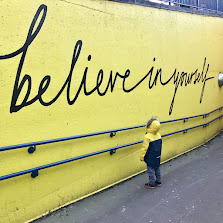The Student Comes First
Today’s post is a reflection on Ms. Sally Utley’s article “Strategies
to Reach Students Who Don’t Care” from The Music Crew Blog. Ms. Utley begins by outlining the
frustration that she and many other educators encounter when they prepare for
an exciting and well-planned out lesson just to have students meet them with
disinterest and negative attitudes. What
kind of kind of experience is this? Certainly not one music teachers want to
repeat.
Why do you think that some lessons are met with hostility?
Perhaps the lesson did not have a good hook or draw the students in. This is
possible but perhaps it is also something that has nothing to do with the
lesson content itself. Ms. Utley goes on to point out that she prescribes to
the saying that “kids don’t care what you know until they know that you care.”
I feel that several experienced music educators would agree with
this expression and would make it a priority to invest valuable class time to
fill this student need. Because that is why we are here, right? We are
teachers, first, to make a difference in our student’s lives. Note, it is easy
for the performance spotlight, fame, money, and all those little professional
expectations that society places upon us to get in the way but the kids must come
first. Consequently, if you make your students your #1 priority then you will
find that, in the long run, you will have plenty of time to teach.
The Interest Survey
If you are new to a school or have new students, Ms. Utley recommends
giving students an interest survey. Not only do you learn of certain trends in
your class, but you will also get to discover the little things nuances make
your students tick.
Ms. Utley recommends you do the following when conducting
surveys:
- Survey students about their musical interests and
experiences, however, ask them more about what other types of interests they
have. These could include sports, other groups they are involved in, colors, foods,
and video games.
- Ms. Utley recalls a colleague recommending that she
should ask students where they are placed in terms of youngest, middle, or
oldest child in their families. She noted that there seemed to be a clear difference
in group work. The most notable differences were between the youngest children
in a family in comparison to those who were the oldest or only child. Why might
this be and how could you instructionally strategize knowing this information?
- Another question that should be asked includes
how many years a child has been at your school. Teachers may find out that those
students that have been at one school may work better together because there is
a better understanding of the rules and procedures. This familiarity to what is
expected in a class may assist in group work efficiency. In addition, teaming a
new student up with a group of students familiar with these expectations could bring
up the effectiveness of the new student.
Consequently, giving out student surveys can also
communicate to your students that their opinions do matter. This leads to more
of a buy-in to what you are trying to teach and the team-oriented culture of
your music program.
By learning what students like it can give you some insight
into certain types of music you might want them to perform. My recommendation
is to start simple by trying to learn their names on day one. Keep it positive
and try to make a personal connection.
Student Greetings
Building relationships with your students is so important if
you want to make a meaningful connection with them. This becomes even more
important when trying to connect with the more challenging students. Ms. Utley
recommends that you should use every possible free moment to build relationships
with these students.
A free moment may include saying something positive to them
or doing a fist pump. Regardless, one or two of these conscious positive
reinforcement efforts could put a smile on the face of a child. This is in
contrast to what other adults may be saying to the child. This simple positive
gesture may take time to take root in a child’s general behavior however the
results will eventually spill into your classroom culture.
Additional ways you can greet your students include:
- Stand outside your classroom door and greet
students as they come into your classroom. - Walk throughout the lunchroom and briefly smile
and greet students as you walk by. - If you are able, ask homeroom teachers if you
could observe a student in their class. Smile and act like you are taking the
notes. Ms. Utley states that you might gain insight on a child that you may transfer
into your class.
Most importantly, keep these interactions brief and
positive. Remember a single smile could brighten up someone’s day.
Build Trust with Immediate Reinforcement
The next recommended strategy that teachers can use to reach
students who don’t care is to build trust with immediate reinforcement. Ms.
Utley stresses the need to stay consistent with our educational behavior
management systems. These consistent learning environments allow students to not only know what to expect but also provides the “space” for them to focus on the academic material being taught.
Often, we think of imposing consequences when rules are broken,
or a child demonstrates negative behavior. But do we always consider an equally
balanced set of positive reinforcement tactics? Often the answer is no, and the
positive reinforcements are necessary if you plan to reach a troubled child.
Unfortunately, sometimes troubled, or distracted children
often lack the motivation to complete assigned tasks. Observing one of these
children may be somewhat exhaustive however, when you catch him or her engaging
in a positive act, following directions, or even providing a correct answer you
must recognize the action right away. This will positively highlight the
significance of the action. For struggling students, this action must be
accompanied by immediate feedback if you want to reach them. If you wait until
the next day, the significance is often faded or forgotten.
One neat strategy that Ms. Utley recommends is to compile a “Great
Job List” of items you have seen a specific student accomplish in the recent
past. Next, ask the child’s homeroom teacher if they could deliver the list to the
student during the homeroom period.
Additionally, you could call the student’s parents and
report on the child’s success he or she had in class for that day. Even if the highlighted
success is small, the parent will more than likely be thrilled to hear the
positive news. More importantly, you would have created a positive
communication conduit with the parents and planted the seeds for a positive
relationship to grow.
Celebrate Successes
Make it a point to celebrate student successes. Often
students may gauge achievements too harshly and these positive reinforcement
opportunities are needed to build a challenging student up. As a music teacher
there are all types of content-oriented opportunities you could choose to celebrate
a student’s success.
Consequently, success celebration should not be just limited
to the classroom content. Make it a point to celebrate things that lead toward
the feeling of intrinsic reward. Utley recommends additional no-cost
celebrations that can implemented in classes include:
- Have a “dance break” cued up to music.
- Create and print mini “good notes” students can
physically take home. - Have a student sit in a special seat, use a
golden stand or hold the token stuffed animal mascot. - Give a student a musical coloring sheet.
- Watch an exciting video at the end of class.
- Or brag about a student or students to the
principal, counselor, or other highly regarded individual.
Conclusion
In conclusion, Ms. Utley has clearly identified that working
with troubled and challenging students is difficult for teachers. Ultimately,
these students will often be unwilling to participate in class activities and tend
to build up a psychological wall. They will need lots of love and patience to
make a positive transformation. Fortunately, with the power you possess as a
teacher, you can make this momentous positive change in disadvantaged child.
Source
Utley, S. (2021,
February 7). Strategies to Reach Students Who Don’t Care. The Music
Crew. https://themusiccrew.com/strategies-to-reach-students-who-dont-care/.







